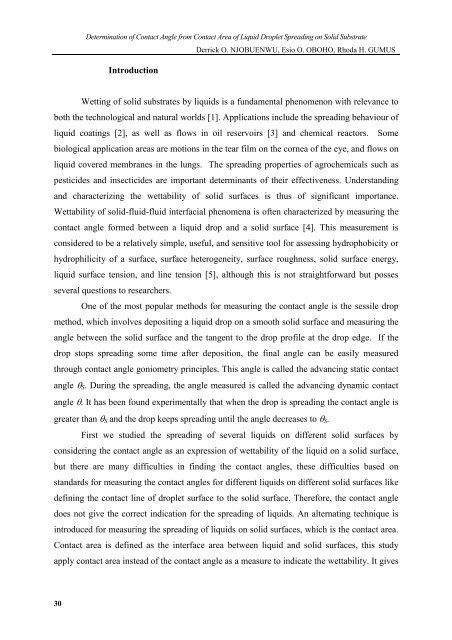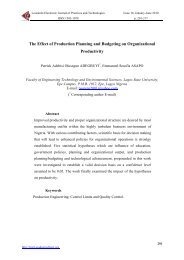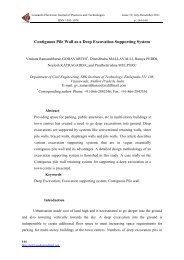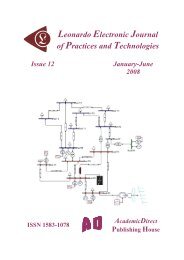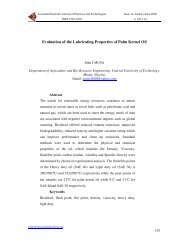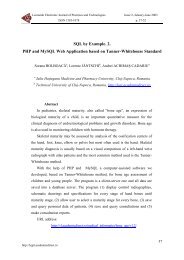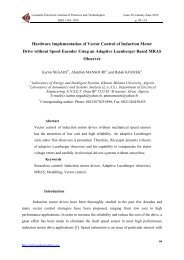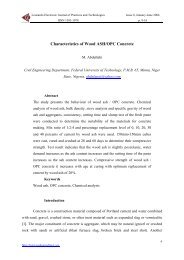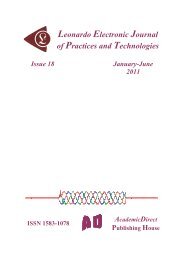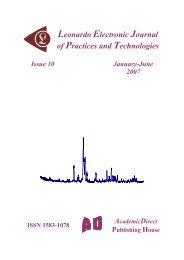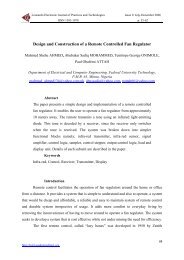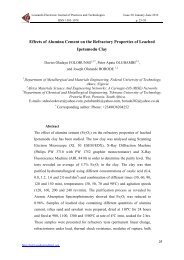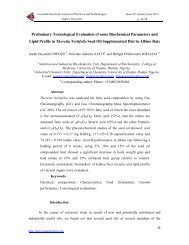Determination of Contact Angle from Contact Area of Liquid Droplet ...
Determination of Contact Angle from Contact Area of Liquid Droplet ...
Determination of Contact Angle from Contact Area of Liquid Droplet ...
Create successful ePaper yourself
Turn your PDF publications into a flip-book with our unique Google optimized e-Paper software.
30<br />
<strong>Determination</strong> <strong>of</strong> <strong>Contact</strong> <strong>Angle</strong> <strong>from</strong> <strong>Contact</strong> <strong>Area</strong> <strong>of</strong> <strong>Liquid</strong> <strong>Droplet</strong> Spreading on Solid Substrate<br />
Derrick O. NJOBUENWU, Esio O. OBOHO, Rhoda H. GUMUS<br />
Introduction<br />
Wetting <strong>of</strong> solid substrates by liquids is a fundamental phenomenon with relevance to<br />
both the technological and natural worlds [1]. Applications include the spreading behaviour <strong>of</strong><br />
liquid coatings [2], as well as flows in oil reservoirs [3] and chemical reactors. Some<br />
biological application areas are motions in the tear film on the cornea <strong>of</strong> the eye, and flows on<br />
liquid covered membranes in the lungs. The spreading properties <strong>of</strong> agrochemicals such as<br />
pesticides and insecticides are important determinants <strong>of</strong> their effectiveness. Understanding<br />
and characterizing the wettability <strong>of</strong> solid surfaces is thus <strong>of</strong> significant importance.<br />
Wettability <strong>of</strong> solid-fluid-fluid interfacial phenomena is <strong>of</strong>ten characterized by measuring the<br />
contact angle formed between a liquid drop and a solid surface [4]. This measurement is<br />
considered to be a relatively simple, useful, and sensitive tool for assessing hydrophobicity or<br />
hydrophilicity <strong>of</strong> a surface, surface heterogeneity, surface roughness, solid surface energy,<br />
liquid surface tension, and line tension [5], although this is not straightforward but posses<br />
several questions to researchers.<br />
One <strong>of</strong> the most popular methods for measuring the contact angle is the sessile drop<br />
method, which involves depositing a liquid drop on a smooth solid surface and measuring the<br />
angle between the solid surface and the tangent to the drop pr<strong>of</strong>ile at the drop edge. If the<br />
drop stops spreading some time after deposition, the final angle can be easily measured<br />
through contact angle goniometry principles. This angle is called the advancing static contact<br />
angle θS. During the spreading, the angle measured is called the advancing dynamic contact<br />
angle θ. It has been found experimentally that when the drop is spreading the contact angle is<br />
greater than θS and the drop keeps spreading until the angle decreases to θS.<br />
First we studied the spreading <strong>of</strong> several liquids on different solid surfaces by<br />
considering the contact angle as an expression <strong>of</strong> wettability <strong>of</strong> the liquid on a solid surface,<br />
but there are many difficulties in finding the contact angles, these difficulties based on<br />
standards for measuring the contact angles for different liquids on different solid surfaces like<br />
defining the contact line <strong>of</strong> droplet surface to the solid surface. Therefore, the contact angle<br />
does not give the correct indication for the spreading <strong>of</strong> liquids. An alternating technique is<br />
introduced for measuring the spreading <strong>of</strong> liquids on solid surfaces, which is the contact area.<br />
<strong>Contact</strong> area is defined as the interface area between liquid and solid surfaces, this study<br />
apply contact area instead <strong>of</strong> the contact angle as a measure to indicate the wettability. It gives


